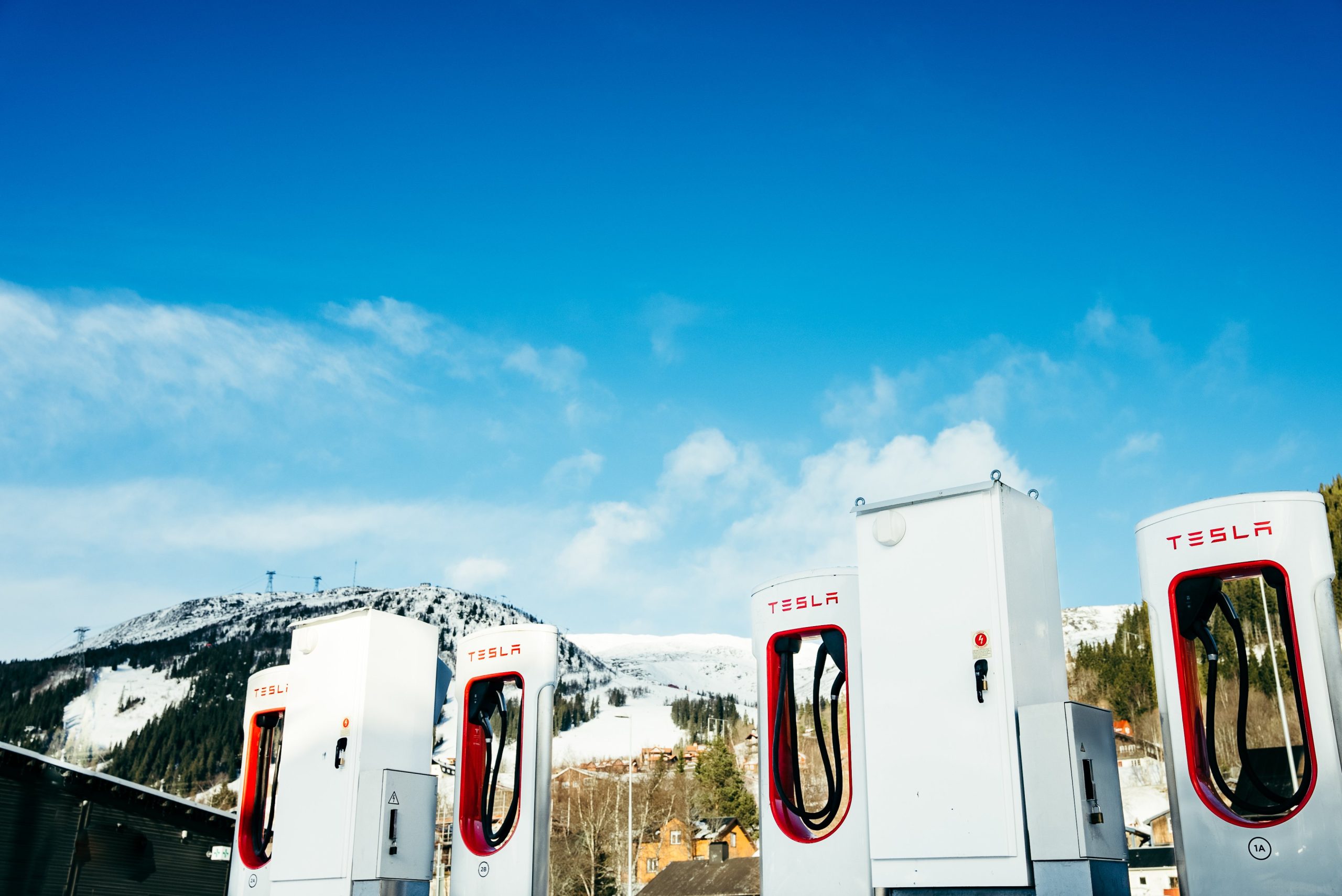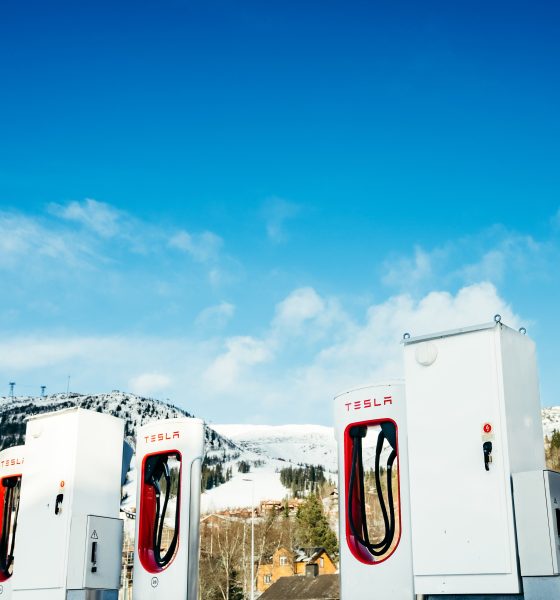

News
Strikes against Tesla Sweden leave over 100 charging stalls waiting for power
Tesla drivers and others with electric vehicles (EVs) have had to wait in line to access the company’s Supercharger stations in Sweden during holiday travel in recent weeks, as ongoing sympathy strikes against the company have blocked more than 100 new stalls from getting energized during the winter season.
Sweden’s largest auto and metalworkers union, IF Metall, has been lodging strike efforts against Tesla for over a year now, and ongoing sympathy strikes with the country’s electric utility operators have managed to prevent the company from bringing new Supercharger stalls online.
In response to a video showing long lines at one Swedish Supercharger station, Tesla Charging Director Max de Zegher said in a post on X on Sunday that the company is still working to roll out new stations, despite the situation leaving over 100 new stalls without electricity.
The executive also said that there was currently “no clear path yet to [the chargers] getting turned on,” adding that Swedish EV drivers are suffering in having to wait, while the move was also preventing the country’s EV infrastructure from keeping up with other regions.
“When Tesla Sweden signs the collective agreement, the strike and sympathy strike ends immediately,” an IF Metall spokesperson wrote in an email to Teslarati.
Specifically, de Zegher said that the company was still rolling out new stations in Malung, Käppen, Vansbro, Idre, Särna, and Sunne, and he encouraged the public in Sweden to reach out to elected officials to help get added sites energized as soon as possible. The news also comes after Tesla officially opened the Supercharger network to all EV brands in Sweden in November.
Teslas (mostly) in the middle of ??Sweden waiting in line at a Superchargerstation in Malung.
Can you count how many there are in line?Because of IF Metall, Tesla can’t connect new stations to the grid.
Crazy, isn’t it!@MdeZegher pic.twitter.com/86XFMUKBSS— Nicklas ???T??♻️? (@NicklasNilsso14) January 5, 2025
You can read de Zegher’s full comment on the matter below:
As forecasted, Swedish EV drivers are suffering and EV infrastructure is not keeping up unless Superchargers get energized by the utilities blocking them from getting energized. Tesla Superchargers are critical infrastructure, especially for peak travel days like this. 100+ stalls in Sweden would have been energized this winter, if it wasn’t for sympathy strikes. Despite no clear path yet to getting turned on, we will also continue to invest and build sites for Swedish EV drivers, including more capacity in Malung, Käppen, Vansbro, Idre, Särna, and Sunne. We appreciate the support from the public to help us get Superchargers energized asap. Waiting in line like this is super painful, hurts EV adoption and totally fixable!
At the time of writing, Swedish utility provider Svenska kraftnät has not yet responded to Teslarati’s request for comment.
READ MORE ON TESLA SWEDEN: Tesla Model 3 named Sweden’s Car of the Year for 2024
Tesla Sweden license plates withheld, with repairs blockade lifted
IF Metall initially launched strike efforts against Tesla Sweden in November 2023, after the company refused to sign a collective bargaining agreement. The labor efforts have since evolved into multiple phases, including efforts to cease imports, withhold Tesla’s license plates for newly registered vehicles, and to halt service and maintenance operations.
Prior to sympathy strikes breaking out over Tesla’s Supercharger stalls connecting to the electrical grid, the company first saw a dockworkers’ union attempt to block vehicles being imported into the country. Tesla later found workarounds for this by delivering the vehicles via ferry from Germany, bypassing the dock’s handling of the units.
Early last year, IF Metall also effectively had a blockade in place on repairs and maintenance at many Sweden-based Tesla service sites, though that was lifted in May as most repairs were approved to continue.
Tesla has also had to find workarounds for IF Metall encouraging PostNord, the country’s leading mail provider, to withhold the delivery of license plates for the company’s newly registered vehicles. Despite the efforts, Tesla has been able to sign a purchase agreement or leasing contract with buyers in advance, having them retrieve their plates and registration documents directly from PostNord and bring them to pick up their vehicles.
What are your thoughts? Let me know at zach@teslarati.com, find me on X at @zacharyvisconti, or send us tips at tips@teslarati.com.
Updated 1/6/25: Added response from an IF Metall spokesperson.
Swedish union pissed off because Tesla is still thriving despite strike: “It’s bullsh*t”
Need accessories for your Tesla? Check out the Teslarati Marketplace:

Elon Musk
Starlink passes 9 million active customers just weeks after hitting 8 million
The milestone highlights the accelerating growth of Starlink, which has now been adding over 20,000 new users per day.

SpaceX’s Starlink satellite internet service has continued its rapid global expansion, surpassing 9 million active customers just weeks after crossing the 8 million mark.
The milestone highlights the accelerating growth of Starlink, which has now been adding over 20,000 new users per day.
9 million customers
In a post on X, SpaceX stated that Starlink now serves over 9 million active users across 155 countries, territories, and markets. The company reached 8 million customers in early November, meaning it added roughly 1 million subscribers in under seven weeks, or about 21,275 new users on average per day.
“Starlink is connecting more than 9M active customers with high-speed internet across 155 countries, territories, and many other markets,” Starlink wrote in a post on its official X account. SpaceX President Gwynne Shotwell also celebrated the milestone on X. “A huge thank you to all of our customers and congrats to the Starlink team for such an incredible product,” she wrote.
That growth rate reflects both rising demand for broadband in underserved regions and Starlink’s expanding satellite constellation, which now includes more than 9,000 low-Earth-orbit satellites designed to deliver high-speed, low-latency internet worldwide.
Starlink’s momentum
Starlink’s momentum has been building up. SpaceX reported 4.6 million Starlink customers in December 2024, followed by 7 million by August 2025, and 8 million customers in November. Independent data also suggests Starlink usage is rising sharply, with Cloudflare reporting that global web traffic from Starlink users more than doubled in 2025, as noted in an Insider report.
Starlink’s momentum is increasingly tied to SpaceX’s broader financial outlook. Elon Musk has said the satellite network is “by far” the company’s largest revenue driver, and reports suggest SpaceX may be positioning itself for an initial public offering as soon as next year, with valuations estimated as high as $1.5 trillion. Musk has also suggested in the past that Starlink could have its own IPO in the future.
News
NVIDIA Director of Robotics: Tesla FSD v14 is the first AI to pass the “Physical Turing Test”
After testing FSD v14, Fan stated that his experience with FSD felt magical at first, but it soon started to feel like a routine.

NVIDIA Director of Robotics Jim Fan has praised Tesla’s Full Self-Driving (Supervised) v14 as the first AI to pass what he described as a “Physical Turing Test.”
After testing FSD v14, Fan stated that his experience with FSD felt magical at first, but it soon started to feel like a routine. And just like smartphones today, removing it now would “actively hurt.”
Jim Fan’s hands-on FSD v14 impressions
Fan, a leading researcher in embodied AI who is currently solving Physical AI at NVIDIA and spearheading the company’s Project GR00T initiative, noted that he actually was late to the Tesla game. He was, however, one of the first to try out FSD v14.
“I was very late to own a Tesla but among the earliest to try out FSD v14. It’s perhaps the first time I experience an AI that passes the Physical Turing Test: after a long day at work, you press a button, lay back, and couldn’t tell if a neural net or a human drove you home,” Fan wrote in a post on X.
Fan added: “Despite knowing exactly how robot learning works, I still find it magical watching the steering wheel turn by itself. First it feels surreal, next it becomes routine. Then, like the smartphone, taking it away actively hurts. This is how humanity gets rewired and glued to god-like technologies.”
The Physical Turing Test
The original Turing Test was conceived by Alan Turing in 1950, and it was aimed at determining if a machine could exhibit behavior that is equivalent to or indistinguishable from a human. By focusing on text-based conversations, the original Turing Test set a high bar for natural language processing and machine learning.
This test has been passed by today’s large language models. However, the capability to converse in a humanlike manner is a completely different challenge from performing real-world problem-solving or physical interactions. Thus, Fan introduced the Physical Turing Test, which challenges AI systems to demonstrate intelligence through physical actions.
Based on Fan’s comments, Tesla has demonstrated these intelligent physical actions with FSD v14. Elon Musk agreed with the NVIDIA executive, stating in a post on X that with FSD v14, “you can sense the sentience maturing.” Musk also praised Tesla AI, calling it the best “real-world AI” today.
News
Tesla AI team burns the Christmas midnight oil by releasing FSD v14.2.2.1
The update was released just a day after FSD v14.2.2 started rolling out to customers.

Tesla is burning the midnight oil this Christmas, with the Tesla AI team quietly rolling out Full Self-Driving (Supervised) v14.2.2.1 just a day after FSD v14.2.2 started rolling out to customers.
Tesla owner shares insights on FSD v14.2.2.1
Longtime Tesla owner and FSD tester @BLKMDL3 shared some insights following several drives with FSD v14.2.2.1 in rainy Los Angeles conditions with standing water and faded lane lines. He reported zero steering hesitation or stutter, confident lane changes, and maneuvers executed with precision that evoked the performance of Tesla’s driverless Robotaxis in Austin.
Parking performance impressed, with most spots nailed perfectly, including tight, sharp turns, in single attempts without shaky steering. One minor offset happened only due to another vehicle that was parked over the line, which FSD accommodated by a few extra inches. In rain that typically erases road markings, FSD visualized lanes and turn lines better than humans, positioning itself flawlessly when entering new streets as well.
“Took it up a dark, wet, and twisty canyon road up and down the hill tonight and it went very well as to be expected. Stayed centered in the lane, kept speed well and gives a confidence inspiring steering feel where it handles these curvy roads better than the majority of human drivers,” the Tesla owner wrote in a post on X.
Tesla’s FSD v14.2.2 update
Just a day before FSD v14.2.2.1’s release, Tesla rolled out FSD v14.2.2, which was focused on smoother real-world performance, better obstacle awareness, and precise end-of-trip routing. According to the update’s release notes, FSD v14.2.2 upgrades the vision encoder neural network with higher resolution features, enhancing detection of emergency vehicles, road obstacles, and human gestures.
New Arrival Options also allowed users to select preferred drop-off styles, such as Parking Lot, Street, Driveway, Parking Garage, or Curbside, with the navigation pin automatically adjusting to the ideal spot. Other refinements include pulling over for emergency vehicles, real-time vision-based detours for blocked roads, improved gate and debris handling, and Speed Profiles for customized driving styles.








